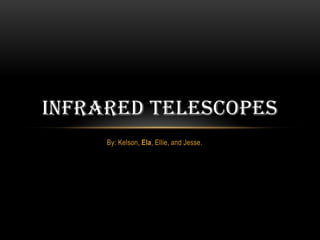
Infrared telescopes kel, jesse, ela, ellie
- 1. INFRARED TELESCOPES By: Kelson, Ela, Ellie, and Jesse.
- 2. WHAT TYPE OF TELESCOPE YOU ARE RESEARCHING Infrared light is one of several types of radiation present in the electromagnetic spectrum. INFRARED TELESCOPE. KELSON
- 3. HOW IT WORKS • An infrared telescope is a telescope that uses infrared light to detect celestial bodies. ELLIE
- 4. WHY WE USE IT Scientist use this telescope to measure the different temperatures of planets, stars, and dust in the galaxy. This telescope also lets scientists be able to see past the proto star and where the actual star is. ELLIE
- 5. WHAT IT NEEDS TO FUNCTION Helium. Solar panel shield. Helium tanks. Aperture doors and photon shutters. Outer shell. Ejectable cover. Barrel Baffle. Focal Surface. Slosh Baffle. And many more that I don’t want to put on because there is like 100,000,000
- 6. PRO’S AND CON’S FOR INFRARED TELESCOPE Pros: • can view farther than the eye. • the image is very very clear from far away. • Infrared waves penetrate dust clouds in space, allowing us to see areas that emit no light. • Cons: • Uses tons of helium and helium is running out really fast. Cannot repair if it is space unless they send a shuttle. • They need huge detectors that take up tons of space. • dry mountains, because there can’t be any water vapor to screw up the signal, and they have to be put high up, because they have to be able to see the stars and planets. jesse
- 7. EXAMPLES FOR INFRARED TELESCOPES • The Spitzer telescope: The Spitzer telescope is NASA’s finial space based telescope and both the Humble telescope and the Spitzer are both included in the space program. It is also made to detect infrared radiation. Launch date is 25 August 2003. • The Hubble Telescope: Launched in 1990 and is one of the longest lasting science projects or missions. It helped determine the age of the universe the identity of the quasars and dark energy. ELA
- 8. A DIAGRAM OF THE INSIDE AND OUT OF THE INFRARED TELESCOPE.
- 9. BIBLIOGRAPHY • ""Ask An Infrared Astronomer: Infrared Telescopes." Ask An Infrared Astronomer: Infrared Telescopes. N.p., n.d. Web. 28 Jan. 2013. • "Hubble Essentials." HubbleSite. N.p., n.d. Web. 28 Jan. 2013. • "Hubble Space Telescope." Wikipedia. Wikimedia Foundation, 27 Jan. 2013. Web. 28 Jan. 2013. • "Infrared Astronomy." Wikipedia. Wikimedia Foundation, 27 Jan. 2013. Web. 28 Jan. 2013. • "Infrared Telescope." Wikipedia. Wikimedia Foundation, 26 Jan. 2013. Web. 28 Jan. 2013. • "Infrared Telescope." Wikipedia. Wikimedia Foundation, 26 Jan. 2013. Web. 28 Jan. 2013. • "Infrared." Wikipedia. Wikimedia Foundation, 28 Jan. 2013. Web. 28 Jan. 2013. • "NASA Infrared Telescope Facility." NASA Infrared Telescope Facility. N.p., n.d. Web. 28 Jan. 2013. • "NASA Spitzer Space Telescope." NASA Spitzer Space Telescope Image. N.p., n.d. Web. 28 Jan. 2013. • Copley, Andrew. "The Disadvantages of Infrared Astronomy." • EHow. Demand Media, 20 June 2011. Web. 28 Jan. 2013.